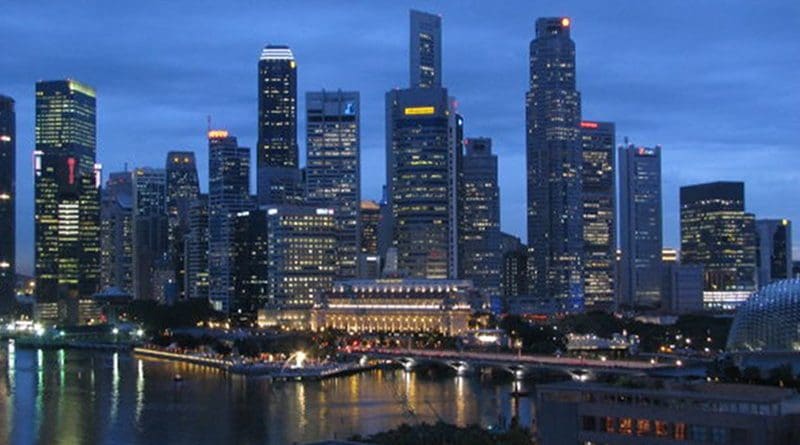Abu Uqayl: Bringing The Threat Closer To Home – Analysis
By Remy Mahzam, Muhammad Faizal Bin Abdul Rahman and RSIS
A recent ISIS video featuring a Singaporean terrorist fighter for the first time attests to the unceasing terrorist threat confronting Southeast Asia including Singapore. It is also a strong reminder of ISIS’ intent to target the wider East Asia.
By Remy Mahzam and Muhammad Faizal Bin Abdul Rahman*
The shrewd use of the media is integral to ISIS’ recruitment success. ISIS strategy includes crafting narratives that spotlight stories of ordinary fighters who are being featured as heroic figures in their military escapades. The promotion of Southeast Asian figures as ideologues in propaganda videos is aimed to motivate and militarise aspiring terrorists in Southeast Asia.
In an unprecedented gambit, a Singaporean terrorist fighter known as “Abu Uqayl” has been featured in the video titled “Inside the Khilafah 4” which was released on 24 September 2017 by ISIS’ official media outlet Al-Hayat. The Singapore Ministry of Home Affairs (MHA) has confirmed his involvement in ISIS and believed that he was radicalised while working abroad. “Abu Uqayl” has joined the ranks of earlier terrorist figures (such as “Jihadi John” and “Abu Jandal Al-Indonesi”) who served as extremist ideologues and in overseas conflicts.
Its release may have been aimed at arousing mistrust between the races and religious groups.
Spotlight on East Asian Jihadists
In June 2016, a 20-minute video “Al-Bunyan Al-Marsus” (The Solid Structure) introduced three East Asian fighters, Abu Walid al-Indonesi, Abu Abdul Rahman al-Filipini and Abu Awn al-Malisi urging their respective comrades from Indonesia, Philippines and Malaysia to unite under the leadership of Isnilon Hapilon and join the jihad in Philippines.
“Inside the Khilafah” is a new video series that continues ISIS’ earlier high-quality media production to promote terrorism; this is achieved by portraying terrorists as heroic figures and perverting religious texts to justify violence. This series, circulated on social media since July 2017, also featured foreign terrorist fighters from the Asia-Pacific region (e.g. Australian “Abu Adam” and Filipino “Abu Yamaan”) who called for jihad in and hijrah to East Asia especially the Philippines.
Although previous ISIS propaganda materials, including those featuring Katibah Nusantara, had already placed Southeast Asia in the ISIS radar and sought to appeal to a Malay-speaking audience, the latest video with “Abu Uqayl” may signal a possible strategic shift.
Strategic Shift?
Firstly, the featuring of an English-speaking Malay person appears to be a stepped-up attempt to reach out to a younger and better-educated audience in a predominantly Malay/Muslim region. Secondly, the video eschews graphic violence (e.g. beheadings) and portrayal of child soldiers dressed in military uniform and brandishing weapons.
Instead, the video highlights the ‘meaningful’ role of ‘Abu Uqayl” as a skilled combatant rather than simply as an ISIS spokesperson, or undertaking menial tasks as lamented by some former ISIS fighters. Thirdly, the mention of Britain’s Prince Harry’s visit by a Singaporean terrorist fighter implicitly suggests that ISIS is aware of key developments – including counterterrorism measures – and the presence of high-value targets in Singapore.
Of immediate concern, this video may possibly embolden more radicalised individuals and groups in Southeast Asia to carry out domestic attacks that ISIS would later claim to authorise.
The global terrorism landscape continues to be dynamic as ISIS is able to persevere in its online radicalisation efforts despite facing heavy military losses in the Middle East.
ISIS is increasingly focusing its attention on East Asia by exploiting local and regional problems especially the current plight of the Rohingya in Myanmar and the security situation in Mindanao, Philippines. To this end, ISIS is driving a wedge between Muslims and Non-Muslims in the region. The featuring of “Abu Uqayl” also suggests that ISIS continues to attract radicalised individuals who may replace earlier terrorist figures who were killed in military strikes by coalition forces in the Middle East.
Moving Closer to Home
Singapore would thus have to continue improving and adapting its CT measures to new developments and challenges. At the community level for example, Singaporeans would need to be more aware and prepared for terror attacks, and continue to be guarded against implicit attempts to spread communal distrust and rock social cohesion. The Straits Times article dated 24 September 2017 which reported a poll’s finding that about 4 in 5 Singaporeans are unprepared for a terror attack is noteworthy.
Singaporeans would thus need to familiarise themselves with emergency preparedness skills and tools (e.g. SGSecure App) as advocated by SGSecure so that they are able to protect themselves and assist the security agencies during a crisis. At the institution level, community leaders and religious figures (Asatizah) who play a crucial role in countering extremist propaganda would need to continue enhancing existing initiatives (e.g. Religious Rehabilitation Group, or RRG app) to challenge the persistence and appeal of ISIS especially on social media.
New initiatives may be needed to protect Singaporeans from being radicalised abroad. In sum, the unveiling of “Abu Uqayl” reiterates that counter-terrorism would be a long struggle for Singapore and that the threat is moving closer to home.
*Remy Mahzam is an Associate Research Fellow at the International Centre for Political Violence & Terrorism Research (ICPVTR) and Muhammad Faizal bin Abdul Rahman is a Research Fellow at the Centre of Excellence for National Security (CENS), from the S. Rajaratnam School of International Studies (RSIS), Nanyang Technological University, Singapore.

